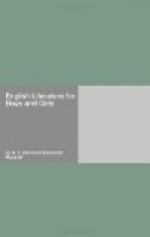So, empty-handed, the messengers returned to Queen Meav. And she, full of anger, decided to make good the boastful words of her messenger and take Brown Bull by force.
Then began a mighty war between the men of Ulster and the men of Connaught. And after many fights there was a great battle in which Meav was defeated. Yet was she triumphant, for she had gained possession of the Brown Bull.
But the Queen had little cause for triumph, for when Brown Bull and White-horned met there was a fearful combat between them. The whole land echoed with their bellowing. The earth shook beneath their feet and the sky grew dark with flying sods of earth and with flecks of foam. After long fighting Brown Bull conquered, and goring White-horned to death, ran off with him impaled upon his horns, shaking his shattered body to pieces as he ran.
But Brown Bull, too, was wounded to death. Mad with pain and wounds, he turned to his own land, and there
“He
lay down
Against the hill, and his
great heart broke there,
And sent a stream of blood
down all the slope;
And thus, when all the war
and Tain had ended,
In his own land, ’midst
his own hills, he died."*
The Tain, by Mary A. Hutton.
The Cattle Raid of Cooley is a strange wild tale, yet from it we can learn a great deal about the life of these old, far-away times. We can learn from it something of what the people did and thought, and how they lived, and even of what they wore. Here is a description of a driver and his war chariot, translated, of course, into English prose. “It is then that the charioteer arose, and he put on his hero’s dress of charioteering. This was the hero’s dress of charioteering that he put on: his soft tunic of deer skin, so that it did not restrain the movement of his hands outside. He put on his black upper cloak over it outside. . . . The charioteer took first then his helm, ridged like a board, four-cornered. . . . This was well measured to him, and it was not an over weight. His hand brought the circlet of red-yellow, as though it were a plate of red gold, of refined gold smelted over the edge of the anvil, to his brow as a sign of his charioteering, as a distinction to his master.
“He took the goads to his horses, and his whip inlaid in his right hand. He took the reins to hold back his horses in his left hand. Then he put the iron inlaid breast-plate on his horses, so that they were covered from forehead to fore-foot with spears, and points, and lances, and hard points, so that every motion in this chariot was war-near, so that every corner, and every point, and every end, and every front of this chariot was a way of tearing."*
The Cattle Raid of Cualnge, by L. W. Faraday.
We can almost see that wild charioteer and his horses, sheathed in bristling armor with “every front a way of tearing,” as they dash amid the foe. And all through we come on lines like these full of color and detail, which tell us of the life of those folk of long ago.




